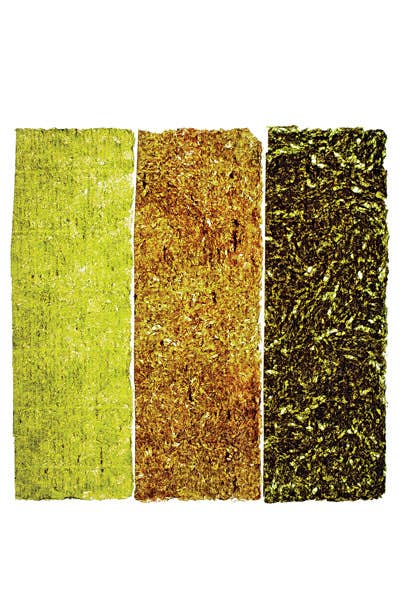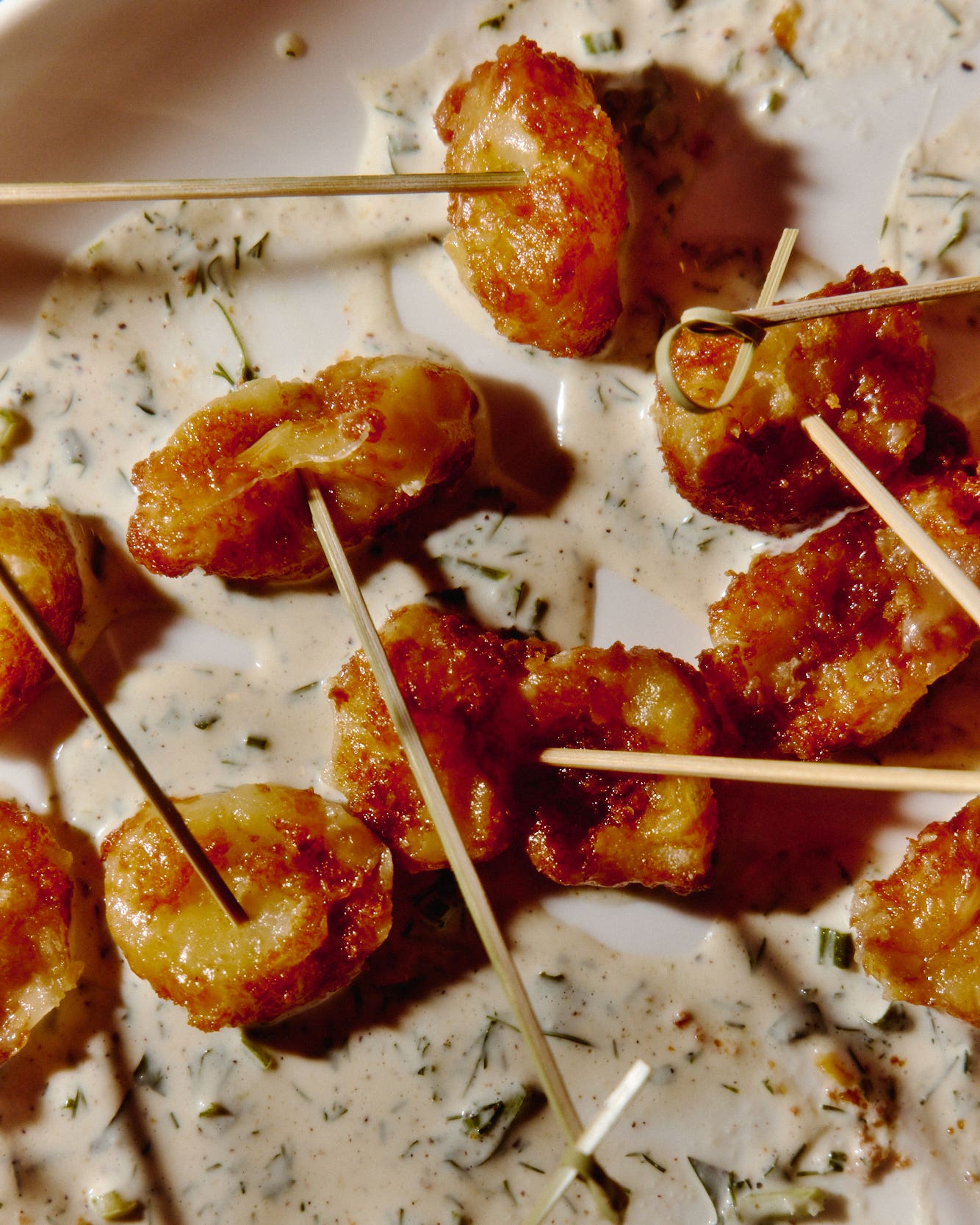
The Beauty of Nori (Japanese Seaweed)
In Japan, this seaweed is a pillar of everyday cuisine
It exists somewhere between the earth and the briny sea. Papery sheets, crisp and fragrant, lavish with what the Japanese prize as umami—mouthwatering savor. Nori, the toasty strips of dried, pressed seaweed that wrap raw fish and other delicacies, is the workhorse of the sushi bar. I love biting into a taut hand roll and feeling the green-black sheath snap between my teeth just as my taste buds are awakened by the nori's saline flavor. But nori is the chorus, not the star; it's overshadowed, in its supporting role, by the celebrity of its sushi-grade fillings. I've studied and written about Japanese cooking for nearly a decade. And I remain amazed by the uncompromising attention to detail that goes into producing foods—from fish to noodles to rice—in Japan.
What about humble nori?
Unlike kelp, wakame, and other forms of edible seaweed that thrive in deeper waters, nori encompasses certain types of algae—colloquially called "seaweed"—that grow in shallow coastal areas. In a process traceable to the 1600s in the city of Edo, now Tokyo, nori was developed by traditional paper makers who applied their craft to press seaweed growing in Tokyo Bay into edible paper. This was used in cooked dishes like soups and eaten plain as an accompaniment to sake. Its standardized dimensions—roughly seven inches by eight and a half inches—have remained unchanged. The dried and toasted sheets became so popular that by the next century, records show a rush of paper makers switching specialties from pressing pulp to processing seaweed.
Today, thanks to modern advances in its cultivation, nori (the word refers to both the plant and the food) is produced in unprecedented quantities in Japan and elsewhere, including Korea and China. Nowhere is it consumed more widely than in Japan. In addition to its service to sushi chefs, nori is a staple of Japanese home cooking. Sheets are brushed with soy sauce and used to scoop up rice at breakfast. Nori confetti is sprinkled over salads, soba and udon noodles, and scrambled eggs. And every convenience store carries nori-wrapped onigiri, or rice balls, packaged in an ingenious cellophane sleeve that keeps the rice moist and the seaweed crisp. Versatile in its uses and packed with vitamins, minerals, and protein, it's the most popular of Japan's many varieties of edible ocean plants. The finest nori is cultivated on Japan's Ariake Sea, some 700 miles to the southwest of Tokyo, in an area known for its nutrient-rich waters. So, I decided to head there during the harvest to better understand this elemental food.
On a frigid February morning, I arrived at the home of Yonetsugu Hatada, a nori farmer whom Japanese friends had arranged for me to meet. Hatada's house sits about a mile from the Ariake Sea, in a flat valley checkered with rice fields and greenhouses where strawberries grow. A vigorous 57-year-old with a wrestler's build and a head that's cue-ball smooth, Hatada has farmed seaweed for more than three decades.
"I just picked fresh nori," he said. "Follow me." We entered a prefab building next door, where the briny aroma of the sea hit us as we made our way to two huge stainless-steel tanks filled with a black-green goop—raw seaweed. Hatada pointed to a whirring, 50-foot-long piece of machinery. I scrambled atop the contraption to watch rushing water pour minced nori into molds. Sponges on mechanical arms pressed the seaweed to a papery thinness before a conveyor belt fed the molds into a slow dryer for curing. I rejoined Hatada below, and he told me that this automated equipment mimics the original handmade process. He and his wife share round-the-clock shifts during the peak of the October-to-May harvest season to painstakingly coax this operation along, carefully monitoring and calibrating the soaking and drying times, the thickness of the sheets, and other factors to produce their nori. He pointed to a worn couch in the corner of the building. "This is where I nap during the season," he said. He led me to the other end of the huge machine, where bundled sheets were being gracefully spit out into neat stacks of nori, some 2 million sheets of which Hatada and his family, including his wife, brother, and sister-in-law, produce per year. All of it is graded according to when it was picked, and then divided into subgrades based on 100 officially established criteria, such as color, shininess, aroma, and softness.
Hatada led me back to his house, where he grabbed two bundles of nori and pulled a sheet from each one. "Our finest and our lowest quality nori," he said. First, he handed me the shin, or top-grade, nori; it was satiny and looked like burgundy-colored onionskin. Seaweed thrives in very cold water, Hatada explained, and this nori had been pressed from tender fronds of the first harvest of winter. Then he gave me the bottom-grade nori, from an autumn harvest. The contrast between the two was remarkable: this one had a noticeably lighter hue, a parchmentlike texture, and none of the sheen of the shin nori.
Hatada invited me into the kitchen, where his wife, Emiko, toasted the sheet of shin by delicately waving it back and forth over a portable gas heater. Toasting is what gives nori its crispness and its green-black color. Virtually all nori sold to restaurants and consumers has already been commercially toasted; this would be my first taste of hand-toasted nori. Biting into a piece of shin nori, I was struck by its crackle, its mere hint of brininess, and its complex umami flavor. It dissolved almost instantly in my mouth. "It just melts," Hatada said approvingly. "The lower qualities, you have to chew more."
Each grade has its culinary purpose, though, Hatada told me. Shin nori is coveted by sushi chefs around the world for its softness. Lesser grades are useful at home in everything from soup broths to salads. And while nori is produced by small-scale and large commercial operations in other parts of Japan, Ariake's is considered the best, said Hatada.
"Come with us tomorrow," Hatada said, "and you'll understand why."
The next day, Hatada and his brother, Yutaka, took me to the source. We punched out to sea in their 45-foot fishing boat.
The 700-square-mile Ariake Sea is a huge bay ringed by forested mountains. When Hatada stopped the boat, the gunmetal-gray waters were as placid as a pond. A 36-square-mile nori field stretched before us, hugging the coast. Thousands of fiberglass stakes poked out of the water in long, orderly rows. Stretched between them were six-by-60-foot nylon nets floating on the surface. Within their webbing, translucent nori fronds rippled beneath the water.
As we took it all in, Hatada explained that rivers running down the mountains spill nutrient-laden sediments into the shallow saltwater sea. Extreme tidal currents—varying by as much as 20 feet—supply oxygen and even more nutrients, creating a rich habitat that has spawned abundant sea life. "Since ancient times the Ariake has been known as the 'treasure ocean,' " Hatada said.
Donning rain suits and balaclavas against the freezing cold, Hatada and his brother climbed into a high-walled dinghy and paddled over to the nets. The little craft was equipped with a seven-foot-wide motorized reel clipper whose spinning blades sent a fusillade of seaweed into the hull. Soon the brothers were standing knee-deep in a sludgy muck that looked about as appetizing as motor oil.
"Here, taste it," Hatada said once they'd loaded the raw seaweed onto the boat. He handed me a few strands of the slimy, forest-green seaweed. "This is the real thing." The seaweed was saline, chewy, and as vegetal as grass cuttings, but I could sense the complex flavors that the finished nori would have. "The best in the world," Hatada said, slapping my back. Then he and his brother jumped back into the dinghy, racing away to harvest more while they still had the tide.
Keep Reading
Continue to Next Story










